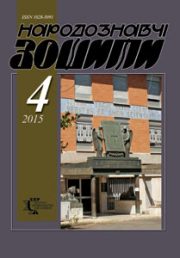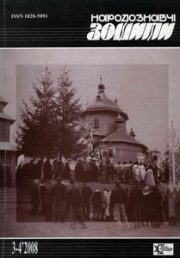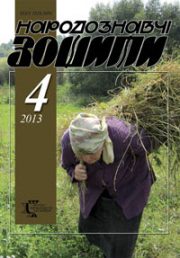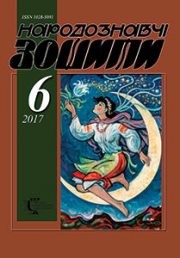The Ethnology Notebooks. 2021. № 4 (160), 864—872
UDK[[73:726.8]:27-526.65/.7/.8](477.83-22)
DOI https://doi.org/10.15407/nz2021.04.864
PEOPLE’S MEMORIAL PLASTICS OF THE DULIBY VILLAGE
TARAS Yaroslav
- ORCID ID : https://orcid.org/0000 – 0001-7241-9466
- Doctor of Historical Sciences, Professor
- Institute of Ethnology of the National Academy of Sciences of Ukraine,
- Head of the modern ethnology department
- boulevard of Freedom, 15, 79000, Lviv, Ukraine
- Contacts: e-mail: etnomod@ukr.net
Abstract. Based on the study of the historiography of the memorial plastics, it was found that it is one of the forms of expression of strength, the indestructibility of the spirit of the nation, associated with the faith of the people, its understanding of the eternal and the passed, good and evil and other universal ethic and moral principles. It was established that with the independence of the Ukrainian state, the study of memorial plastics not only of separate historical and ethnographic district, but also of each settlement, will resurrect the glorious past, will make it possible to fully reveal the history of the Ukrainian people.
The article considers the customs to put crosses in Ukraine as a sign of important events. Particular attention is paid to the installation of crosses on the «abolition of the serfdom». Based on the study of archival sources, military maps Galizien und Lodomerien (1779—1783), Galicia and Bucovina (1861—1864), Habsburg Empire (1869—1887) it was found that at the beginning and on the edge of the village Duliby were installed talismanic crosses that are not preserved. Memorial crosses that exist in the village today have been discovered. This is an offir cross, established in 1888 by Mavei and Anna Kuleshnyk; cross for the abolition of the serfdom and the cross of salvation of people from troubles established by the village community in 1894. Particular attention is paid to the offir cross, built in 1937 by Yurko and Anna Hrynkiv.
Grave monuments on the cemetery near the church, which have pronounced symbolism and artistic value, indicate the history of their appearance and symbolism. Attention is drawn to the tombstone with the pedestal which supports the epitaph table with its horns. It turns out that in the center of the village there is a figure of Jesus Christ and the chapels, which are located in the old part of the village and on the territory of the former village. It is proposed to designate monuments, memorial signs of famous people that are connected with the village of Duliby and who left their mark in the history of the village – I. Franko, L. Shankowski, E. Olesnitsky.
Keywords: village Duliby Stryi district, memorial plastics, cross, abolition of the serfdom, tombstone, monument.
Received 12.07.2021
REFERENCES
- Malyna, V. (2008). The structure of the functions of the stone cross. Ukrainian art history: materials, research, reviews, 8. Kyiv: IMFE by M.T. Rylsky NAS of Ukraine [in Ukrainian].
- Popelnytska, O. (2009). State of Specific Historical Subject of Staurology Studies in Ukraine: Problem Formulation. Ukrainian Historical Journal, 3 [in Ukrainian].
- Shyrocky, K. (1908). Tomb crosses in Ukraine. The Notes of the NTSh (Vol. LXXXII). Lviv [in Ukrainian].
- Koltsunyak, G. (1919). Folk crosses in Kolomyja region. Materials for Ukrainian ethnology (Vol. XIX—XX). Lviv [in Ukrainian].
- Sumtsov, N. (1890). Cultural experiences: Field crosses or figures. Kievskaya starina (Vol. XXX) [in Russian].
- Scherbakivsky, D. (1926). The Ukrainian Art (Vol. 2): Bukovynian and Galician wooden churches, graveside and wayside crosses, figures and chapels. Kyiv: Ukrainian Public Publishing Fund [in Ukrainian].
- Maslov, L. (1937). Roadside crosses of Northwest Volyn. Church and people, 8. Kremenets [in Ukrainian].
- Tsinkalovsky, O. (1936). Volyn tomb crosses. Zhyttia i znannia, 10. Lviv [in Ukrainian].
- Tsinkalovsky, O. (1936). Wooden crosses in Polissia. Zhyttia i znannia. Lviv [in Ukrainian].
- Tsinkalovsky, O. (1935). Stone crosses in Volyn. Zhyttia i znannia. Lviv [in Ukrainian].
- Malyna, V. (2009). Stone crosses in Ukraine. XVIIIth to XXth Centuries: Ontology. Typology. Symbolics. Function. Mykolayiv: Art Goods Artil [in Ukrainian].
- Shudliak, N. (2016). Roadside crosses of Vinnitsa region (materials of field research). Young scientist, 11 (38) [in Ukrainian].
- Kukharenko, S. (2010). Roadside monuments: a modern phenomenon, or the pull of folk traditions. The Ethnology Notebooks, 3—4 [in Ukrainian].
- Ignatenko, I. (2009). «Figures» and arched crosses in the spiritual culture of Ukrainians of Polissia. Ethnic history of the peoples of Europe, 30 [in Ukrainian].
- Ignatenko, I., Nagorniuk, O. (2013). Roadside crosses of Polissia: functions, semantics and symbols. The Ethnology Notebooks, 1 [in Ukrainian].
- Mozdyr, M. (2018). Landscape crosses and «figures». Church art of Ukraine: in 3 vol. (Vol. 1. Architecture. Monumental art). Kharkiv: Folio [in Ukrainian].
- Mozdyr, M. (2009). The Ukrainian Folk Memorial Plastic Art. Lviv: NAS of Ukraine, Institute of Ethnology [in Ukrainian].
- Pavlyuk, S. (Ed.). (2018). The Church art of Ukraine: in 3 vol. (Vol. 1. Architecture. Monumental art). Kharkiv: Folio [in Ukrainian].
- Stankevych, M. (Ed.). (2006). Dictionary of Ukrainian Sacred Art. Lviv: Institute of Ethnology of the NAS of Ukraine [in Ukrainian].
- Pavlyuk, S., Stankevych, M. (Eds.). (1997). Ukrainian Crossology: Art Studies. Lviv [in Ukrainian].
- Stankevych, M. (Ed.). (1996). Cross in Ukrainian art: exhibition catalogue. Lviv [in Ukrainian].
- Maslov, L. (2009). Roadside crosses of Northwest Volyn. One reliable life… Lutsk [in Ukrainian].
- Franko, I. (1986). Serfdom and its abolition in Galicia. Collection of works in 50 volumes (Vol. 47). Kyiv: Naukova dumka [in Ukrainian].
- Literary hour to the 160th anniversary of the abolition of serfdom in Galicia. Retrieved from: https://zal-lib.pp.ua/vesna-voli-literaturna-godyna-do-160-richchya-skasuvannya-kripatstva-v-galychyni/
- Bodnaruk, I. (1990). The parnassus of the Stryi region. The Stryi Region: Stryi, Skole, Bolekhiv, Dolyna, Rozhnitiv, Zhuravno, Zhydachiv, Mykolaiv N/Dn. A Collection Of Essays (Vol. 2). New York: Stryishchyna Committee [in Ukrainian].
- Taras, Ya. (2018). Life confession of 95-year-old Dulibchanka. Dzvin, 10 [in Ukrainian].
- Belov, O., Shapovalov, G. (2008). Ukrainian trident. Zaporizhzhia: Wild Field [in Ukrainian].







